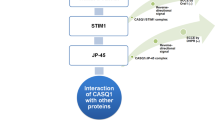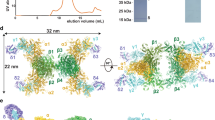Abstract
THE adenosine triphosphatase (ATPase) activity of human skeletal muscle is confined to the A-bands (except the H-band portion)1 when fresh-frozen tissue is cut in a cryostat, the sections dried on coverslips, and the Padykula–Herman2 standard incubation medium used (20 min 37° C, pH 9.4, 405 mM ATP, 18 mM Ca++, no Mg++). However, if the sections are put in the incubating medium before being dried, additional ‘wet ATPase’ activity is seen in the intermyofibrillar regions of all the muscle fibres (Fig. 1)3. Further investigations have now disclosed that the wet ATPase activity in the intermyofibrillar region is located at the level of the A-band and I-band junction, as seen in longitudinal sections (Fig. 2). This is the precise location of the sarcoplasmic reticulum triads and of no other constituent in human skeletal muscle cells, as disclosed by electron microscopy4. Wet ATPase activity also occurs in the sarcolemmal membrane (Fig. 3) and is qualitatively like the sarcoplasmic reticulum triad ATPase. There is increased sarcolemmal activity periodically at the level of triad activity seen in longitudinal sections (Fig, 3), The wet ATPase occurs in the muscle nucleoli but not in the muscle mitochondria. Under the conditions used, the sarcoplasmic reticulum triad and sarcolemmal ATPase produce a darker staining than the myofibrillar A -band ATPase.
This is a preview of subscription content, access via your institution
Access options
Subscribe to this journal
Receive 51 print issues and online access
$199.00 per year
only $3.90 per issue
Buy this article
- Purchase on Springer Link
- Instant access to full article PDF
Prices may be subject to local taxes which are calculated during checkout
Similar content being viewed by others
References
Engel, W. K., J. Histochem. Cytochem., 10, 229 (1962).
Padykula, H. A., and Herman, E., J. Histochem. Cytochem., 3, 170 (1955).
Engel, W. K., Neurology, 12, 778 (1962).
Huxley, H. E. (unpublished observations). See also van Breemen, V. L., Amer. J. Path., 37, 215 (1960); Andersson-Cedergren, E., J. Ultrastr. Res., Suppl. 1, 126 (1959). Porter, K. R., J. Biophys. Biochem. Cytol., in suppl. “The Sarcoplasmic Reticulum”, 10, 219 (1961). Revel, J. P., J. Cell Biol., 12, 571 (1962).
Bonting, S. L., Caravaggio, L. L., and Hawkins, N. M., Arch. Biochem. Biophys., 98, 413 (1962).
Gauthier, G. F., and Padykula, H. A., J. Histochem. Cytochem., 10, 661 (1962).
Novikoff, A. B., Essner, E., Goldfischer, S., and Heus, M., in The Interpretation of Ultrastructure, I, 149, edit. by Harris, R. J. C., (Academic Press, New York, 1962).
Muscatello, U., Andersson-Cedergren, E., Azzone, G. F., and von der Decken, A., J. Biophys. Biochem. Cytol., in suppl. “The Sarcoplasmic Reticulum”, 10, 201 (1961).
Author information
Authors and Affiliations
Rights and permissions
About this article
Cite this article
ENGEL, W. Adenosine Triphosphatase of Sarcoplasmic Reticulum Triads and Sarcolemma identified histochemically. Nature 200, 588–589 (1963). https://doi.org/10.1038/200588a0
Issue Date:
DOI: https://doi.org/10.1038/200588a0
This article is cited by
-
On the specificity of the histochemical technique for sarcoplasmic reticular adenosine triphosphatase: A light and electron microscopic study
Histochemistry (1975)
-
A modified histochemical technique for sarcoplasmic reticular ATPase
Histochemie (1972)
-
Ultrastructural localization of adenosinetriphosphatase activity in skeletal muscle by calcium precipitation at high pH
Virchows Archiv B Cell Pathology (1969)
-
Two ATPases in the Sarcoplasmic Reticulum of Skeletal Muscle Fibres
Nature (1967)
-
Zytochemische lokalisation und charakterisierung von phosphatabspaltenden fermenten im sarkotubul�ren system quergestreifter muskeln
Histochemie (1967)
Comments
By submitting a comment you agree to abide by our Terms and Community Guidelines. If you find something abusive or that does not comply with our terms or guidelines please flag it as inappropriate.



